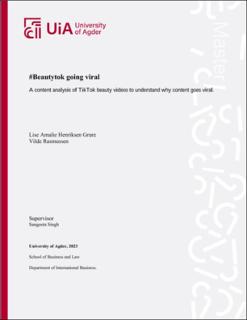| dc.description.abstract | Purpose: The primary goal of this master's thesis is to examine the factors contributing to the virality of beauty product user-generated content (UGC) on TikTok. It is crucial since TikTok is a relatively new social media platform, and having a deeper understanding of it would help consumers, digital marketers, and brands expand their reach on TikTok.
Problem statement: Why beauty product-related UGC goes viral on TikTok, and what characteristics do the videos have?
Design/methodology/approach: It applies a mixed-method approach that combines qualitative and quantitative analysis. A qualitative content study of 350 TikTok videos is used to create the dataset. This was followed by a quantitative ANOVA analysis in SPSS to determine whether or not the hypotheses were supported.
Findings: Five out of nine hypotheses were confirmed. The main findings demonstrated that several characteristics are crucial for creating a viral video. Hypotheses in all three groups, content-, product- and messenger characteristics, were supported. This demonstrates that when creating a TikTok video to go viral, the product should be unique or unusual, be innovative, and solve a problem. Lastly, the messenger of the video should be an expert on the topic.
Practical implications: This thesis can be used by marketers to develop more effective marketing plans for TikTok and other social media platforms. Additionally, a deeper comprehension of how current and potential customers respond to online content can help improve and adapt current social media marketing initiatives. This is important for brands that apply social media to market and sell their products.
Keywords: TikTok, user-generated content, electronic word of mouth, social media, virality | |
